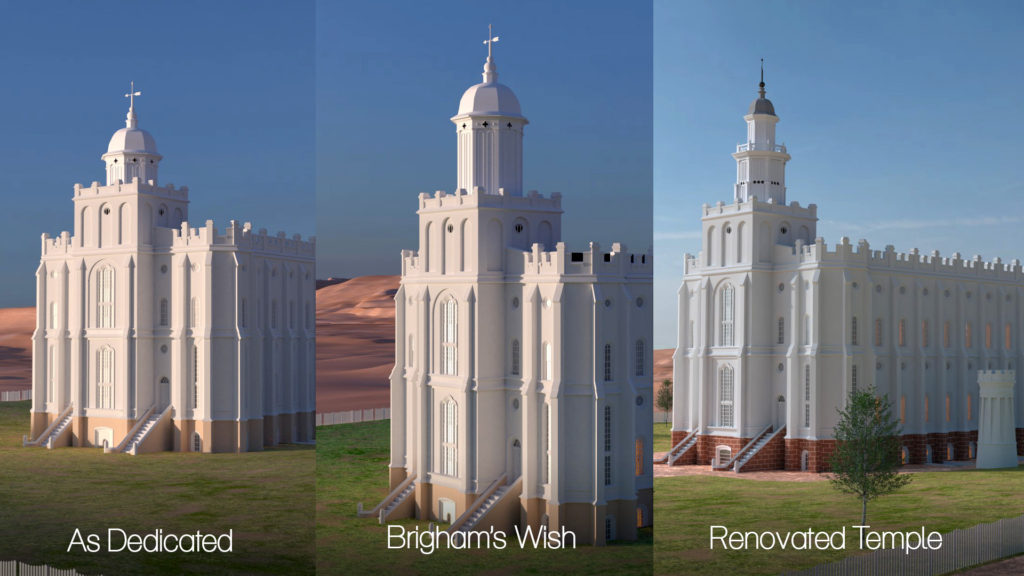UPDATE!
Due to recent discoveries I have made, I have found that this particular model is inaccurate. Specifically, this model represents a state of the temple that did not and never did exist. Instead, the next video, depicting the first annex, is the next stage in the evolution of the temple. :https://photogent.com/historic-temple-video-series-st-george-utah-temple-1888-1900/
This is the second historic variation of the St. George Utah Temple, and it features the first appearance of the new, taller, spire for the temple.
The Lightning Myth
Much has been said about how the spire came to be, and the stories are, more often than not, wrong. Tradition holds that Brigham Young hated the short spire, and demanded the spire be replaced with a taller one. The saints, however, were tired of the labor of building the temple, and refused, with President Young eventually relenting. The temple was dedicated 6–8 April 1877, with Brigham in attendance. President Young would then pass away August 29, 1877 Just over four months later.
Then, in a violent storm in October of 1878, just 14 months after Brigham’s passing, the tower is struck by lightning, and burned down to the rock underneath it. The local saints, humbled by the event and mindful of Brigham Young’s desires, rebuild the spire, taller this time.
The Enlightened Truth
Brigham Young was not well as the temple neared completion. For the last few years of his life, He wintered every year in St. George, finding the environment better for his health. During his visits, he spent nearly every day at the temple. With Truman O. Angell, the temple’s architect, in Salt Lake working on the Temple there, Brigham was the first and last word on all things relating to the temple’s construction during his visits, the Temples only on hand architect.
During one of his visits to St. George, President Young took a private tour of the temple with his son and then apostle, Brigham Young Jr. on May 10, 1876. Elder Young recorded the visit in his journal as follows:
“The tower is wooden and very unsatisfactory piece of work,” Young, Jr. wrote in his journal. “Father remarked he would keep the tower locked, that he was ashamed of the framing and the design. It was is some 12–18 feet too low to look well. Prest [Brigham Young, Sr.] says they will have that remided [remedied] some these days,” (Brigham Young Jr., Journal, May 10, 1876, 83).
There is no recorded evidence, anywhere, that anyone other than Brigham Jr. knew of his father’s dislike of the spire. The journal itself would not be discovered by researchers until the 1970s, which, coincidentally, seems to be about the same time the first recorded versions of this myth came into being.
It is also interesting to note that President Young only wanted the spire 12-18 feet taller than the dedicated version (left.) The end result would have looked more like The middle image, and not the final finished spire (right.)

The lower portion of the modern temple is placed at about the same height Brigham wished he had made the entirety of the spire to begin with.
There is evidence that temporary repairs were done to the tower (which was severely damaged, but not burnt completely down) in 1878. Letters between local authorities go into great detail as to the level of damage the tower and other portions of the roof received. They are decidedly absent of mentions of Brigham Young, or any concerns about the size of the now damaged spire.
The New Tower
The decision to make a taller tower would be made about 21 months after repairs on the original spire were completed. Announcements of the pending renovation and change were made both in the local papers and papers in Salt Lake City. None of these articles mention either Brigham Young or the lightning strike of two years prior. However, the tower was not made taller until 1883, 5 years after the strike. News reports at the time of the spire replacement announcement and the construction of the taller tower made no mention at all of Brigham Young.
Origin Of The Myth
Well, as these things sometimes happen, the Journal entry of Brigham Young Jr. was discovered in the 1970s, and someone, somewhere, likely related the story of Brigham wishing the spire was taller along with a reference to the lightning strike. In 1977, the first printed version of this story appeared in The Color County Spectrum and soon a similar story appeared in St. George Magazine, only this time with more details than had been shared in print before. In future print versions, the story would continue to receive even more new details and variations. In what was probably a matter of months, an off handed story along the lines of “wouldn’t it be funny if” became a full on struggle between the prophet and his people over who was going to have the final say in the design of the temple.
Sources
The information from this article came from the following:
The St. George Temple Tower: Evolution of a Design
Darrell E. Jones
Journal of Mormon History
Vol. 34, No. 2 (Spring 2008), pp. 113-129
All That Was Promised
The St. George Temple and the Unfolding of the Restoration
Blain M. Yorgason, Richard A. Schmutz and Douglas D. Adler
2013, Deseret Book
Footnote #5, pages 320, 321

There is a photograph of the St. George temple at night, and the angle of the floodlights leaves a shadow on the tower that looks like a large man sitting at a desk. The visitor center missionaries used to say it was the spirit of Brigham Young protecting the “Corrected” tower. As young people, we knew it was just a story, but we got a kick out of it.
I have NEVER heard this story before! I love it!